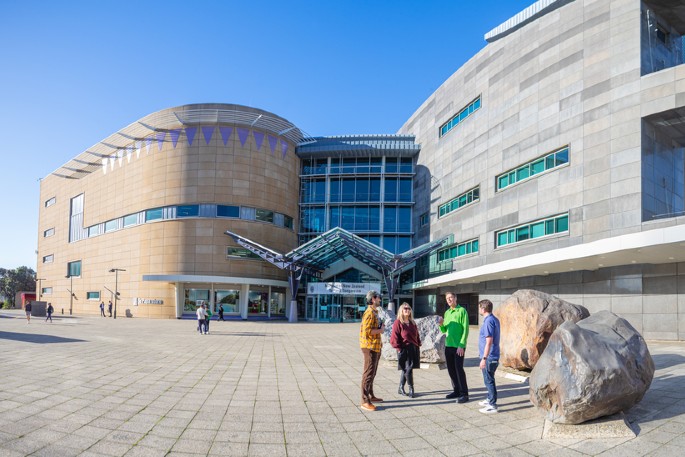This Content Is Only For Subscribers
August 2025 marks a century since the colossal squid (Mesonychoteuthis hamiltoni) was first named by the scientific community in 1925.
Te Papa is home to the world’s only complete specimen on public display.
From deep sea to deep fame, this iconic animal at Te Papa has captured millions of hearts since her arrival, and 17 years on she’s considered one of the museum’s most beloved taonga (treasure) that continues to inspire awe and curiosity.
Now preserved in a specially designed tank in Te Taiao | Nature exhibition, the colossal squid was originally found in February 2007 by the vessel San Aspiring, in the Ross Sea, Antarctica.Te Papa Kaihautū | Māori Co-Leader Dr Arapata Hakiwai recalls when the colossal squid arrived at Te Papa in 2008.
“It wasn’t just a scientific marvel; it symbolised the wonder of nature and connected us to the mysterious world of the ocean. There was something very special about being able to share that with our visitors.”
For Te Papa Tumu Whakarae | chief executive Courtney Johnston, it’s witnessing the squid’s cult following that brings her joy.
“No matter how many times I walk past, I’m always blown away by how people of all ages react to the squid – they are completely captivated.
“There’s this special moment of awe, like they’ve stumbled upon something truly otherworldly, and that never gets old.”
Adding to the centenarian celebrations, Te Papa has just been named TripAdvisor’s top tourist attraction in New Zealand, placing it in the top 1 per cent of attractions worldwide. So, it’s official: tentacles down, the colossal squid is New Zealand’s number one attraction.
Te Papa invites everyone to celebrate this deep-sea diva by visiting the world’s only whole colossal squid on display, in the Te Taiao | Nature exhibition. Explore the squid’s anatomy, learn about her journey from Antarctica, and even touch models of her beak and tentacle.
Kerry Walton, curator invertebrates, is a sucker for the colossal squid, the largest invertebrate on the planet.
“I am biased, but I love the fact that the most popular exhibit at Te Papa is an invertebrate.
“This is one of nature’s most elusive creatures, so rarely seen that visitors to Te Papa are among the few in the world who get to stand face-to-face with a creature that most scientists only dream of seeing – it’s like winning the deep-sea lottery.”
Along with being a world-class visitor attraction, the national museum is home to a globally-rated research facility, and holds some of the only colossal squid specimens in the world.
“Not only do we have the only whole specimen on display, but in our collection, we hold two other large, intact specimens, plus several beaks and other parts”, says Kerry.
Kat Bolstad, Associate Professor of Environmental Science at Auckland University of Technology and leader of the AUT Lab for Cephalopod Ecology a Systematics (AKA the AUT Squid Squad) has long studied the systematics and ecology of squids and is a regular collaborator with the national museum.
“These animals live in an enormous, remote, dark, and three-dimensional environment – and are probably avoiding us.
“Predators and scavengers, such as whales, fishes, and seabirds remain one of our best sources of information about the colossal squid,” says Kat.
In 2014, the third of these complete specimens was examined by specialists in squid biology, led by Kat.
In a shared moment of wonder, the event was livestreamed, drawing global attention and viewed by more than 900,000 people worldwide.
In what seems to be the year of the squid, March saw a groundbreaking scientific moment with the first confirmed footage of a live colossal squid in its natural habitat. Captured by the Schmidt Ocean Institute’s ROV SuBastian, the footage revealed a baby colossal squid, just 30 cm long, offering a rare glimpse into the life cycle of this elusive creature.
You don’t have to be in the capital to learn about the colossal squid; Whiti: Colossal Squid of the Deep, a 32-page illustrated Te Papa Press book for children, tells the story of a colossal squid’s life; a free, downloadable colossal squid activity book is available on the Te Papa website, and a special, touring exhibition allows those around the motu to engage with an interactive display and model parts.
Colossal Squid: Freaky Features! has been touring for almost four years, been to 14 museums and libraries across 10 regions, visited by more than 79,000 people, and currently on display in Warkworth District Museum until August 17.
Colossal squid by the numbers
The colossal squid on display at Te Papa is 4.2 metres long, weighs 495kg and has had approx. 9 million visitors.
More than 900,000 viewers watched the examination of a colossal squid at Te Papa in 2014
Mature colossal squid can probably weigh >500kg.
They live at depths of 1000 metres or more.They might form as much as 77 per cent of a sperm whale’s diet.



